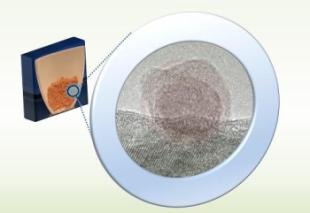Nov 7 2017
Although nanoparticles with controllable size and composition find wider application in optical, electrical, and chemical devices, they ought to be developed in a cost-effective and safe manner.
At present, Kazuhiro Takanabe and his colleagues, from KAUST, have developed a simple technique for low-temperature production of metal-sulfide nanoparticles without the use of solvents that are harmful to the environment.
 Metal-sulfide nanoparticles synthesized using a simple method in a semiclosed crucible are characterized with high-resolution TEM. CREDIT: 2017 KAUST.
Metal-sulfide nanoparticles synthesized using a simple method in a semiclosed crucible are characterized with high-resolution TEM. CREDIT: 2017 KAUST.
Metal sulfides—crystalline materials synthesized by combining one or multiple metal atoms with sulfur atoms—have exceptional optical, electronic, and thermoelectric characteristics. Nanoparticles of such materials seem to be an exciting prospect for creating miniaturized devices. However, the creation of such minute devices is largely dependent on a safe, effective, and simple technique for developing metal-sulfide nanostructures, ideally on a commercial level. The ideal technique must not use high temperatures or solvents that have a negative effect on peoples health and on the environment.
At present, Takanabe and his colleagues have described a solvent-free technique for synthesizing a broad array of metal-sulfide nanoparticles by making use of a sulfur-containing organic compound known as thiourea.
Most importantly, the sulfide materials of interest can even be produced in an open environment. “Our aim was to make synthesis both simple and robust,” stated Takanabe.
The researchers added thiourea and a nitrate or oxide of the metal, or multiple metals, to a crucible. The thiourea gets melted upon being heated to a comparatively low temperature of 200°C. This provides the sulfur atoms that are needed and acts the same as a solvent in a traditional process, functioning as the base centers that react with the metal source.
The researchers adopted their technique to synthesize complex quaternary metal-sulfide nanoparticles, that is, CuGa2In3S8. It was seen that an organic polymer was simultaneously formed outside the sulfide nanoparticles, thereby forming a capping layer. They used high-resolution transmission electron microscopy (TEM) and solid-state nuclear magnetic resonance (NMR) methods to characterize the materials to analyze its morphology and to interpret the capping polymer.
In this paper, the Core Lab undertook the materials analysis with NMR and TEM, which was crucial for relating the size of silica nanoparticles to their dielectric properties. TEM analysis produced the images of the nanoparticles, acquired at nanometer-scale resolution and hence made it easy to estimate the dimensions of the nanoparticles. Moreover, the electron prism fitted in the TEM instrument allowed determining the spatial distributions of constituent elements in the nanoparticles, which also turned out to be equally important in this work.
Kazuhiro Takanabe, KAUST
The outcomes of the study indicate that an organic carbon nitride polymer was controllably formed around the outer side of the nanoparticles. However, the accurate composition of the polymer is more reliant on the precursor ratios as well as the synthesis temperature.
Takanabe and his colleagues demonstrated the efficacies of their nanoparticles by employing them as a photocatalyst to carry out hydrogen evolution. Here, the poisonous sulfur ions are rendered safe in an aqueous solution. “This study opens up the new synthesis protocol to metal sulfide nanoparticles, which are useful for various applications,” stated Takanabe.
“We are fortunate that this Core Lab provides researchers with high-quality materials analysis by procuring state-of-the-art instrumentation and the best talent,” added Takanabe.